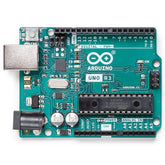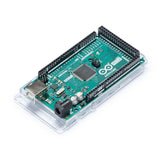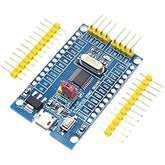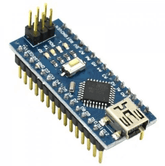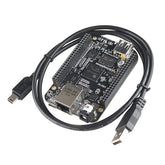Difference between Microprocessors & Microcontrollers
Summary
Do you want to Unlock the potential of Microprocessors and Microcontrollers? If the answer is yes! then this blog is a compulsory perusal for those who aspire to fathom these crucial constituents of modern electronics. The blog endows a profound perspective of microcontrollers, encompassing their fundamental components, applications, and programming methodologies. Additionally, it probes microprocessors, their utilization, and cardinal discrepancies from microcontrollers. With its enlightening content and captivating prose, this blog is an invaluable resource for students, enthusiasts, and practitioners alike.
Often times when we deal with electronics and programming we will always come across terms such as microprocessor or microcontrollers. The crazy part is that it's quite a simple concept but many blogs and articles sometimes use the term interchangeably which ends up confusing more people.

So in this blog, we will be discussing in detail what each term means, their differences, and their use cases. And hopefully, in the end, it will let you make an informed decision in your future DIY projects
What are Microcontrollers?
Microcontrollers are compact systems designed to perform a specific task repeatedly or continuously. These are majorly used in embedded systems, where the system itself is only used to perform a specific task or a specific function. They are compact, power-efficient, and can be reprogrammed using another system as needed.
Common examples of Microcontrollers are Arduino Boards, ESP family boards, PIC, etc
Microcontrollers come in various forms and configurations depending on the requirement. They can be as simple as an 8-bit microcontroller ranging to the 32-bit microcontroller for more applications where more precision and interfaces are required.

Components in a Microcontroller
Since microcontrollers are designed to be compact and power-efficient, most components required are built on a single chip which includes
- RAM
- ROM
- IO bus
- Microprocessor
- Timers

While this monolithic approach improves efficiency and reduces the footprint of the device, it comes at the expense of a lack of upgradability/expandability.
Where are Microcontrollers used?
Microcontrollers are used in application-specific scenarios where the microcontroller may be coded to run one particular function on repeat. This allows us to tailor microcontrollers for specific needs thereby reducing overheads.
Some examples of where microcontrollers are used are
- IoT devices
- Washing Machines
- Refrigerators
- Air conditioners
- Calculators
- Microwaves
How are Microcontrollers programmed?
Microcontrollers are usually programmed using a PC or a dedicated flasher. They will contain drivers or specific software that will be able to compile high-level language code like C/C++, Rust, and micropython to binary files - a format of files that the microcontroller can understand.
Once uploaded, the microcontroller starts running the dedicated code continuously over and over again until it is powered off. To restart the program, one just simply needs to disconnect and reconnect power to the microcontroller.
For example, for AVR-based boards like Arduino, Arduino IDE is commonly used on PCs and Macs to program AVR devices. The user can write their code on Arduino IDE and then compile the code in binary or hex file. Once done, the program uses a flasher-like avrdude to flash the generated binary/hex file onto the Arduino’s program memory via a Serial or USB connection. Once uploaded, the IDE verifies that the program has been successfully uploaded and the microcontroller starts executing the uploaded code immediately.
There are many other tools and software available to flash other microcontrollers. For example, Atollic Studio is used to program STMs and PlatformIO is a popular VSCode extension that supports most of the popular microcontrollers available on the market.
What are Microprocessors?

Microprocessors are chips that perform actual computation. A microprocessor is a controlling unit of a micro-computer wrapped inside a small chip. It performs Arithmetic Logical Unit (ALU) operations and communicates with the other devices to which it is connected.
Microprocessors need to be connected to external RAM, ROM, and peripheral interface, unlike Microcontrollers. This offers flexibility in user configuration but comes at the cost of compactness and cost.
However unlike Microcontrollers, Microprocessors are used in tandem with other peripherals to form a powerful computing device, often times much more capable than a typical microcontroller
Some examples of Microprocessors are the Intel and AMD chips used in PCs
Where are Microprocessors used?
Microprocessors are used in General Purpose PCs and devices such as the Raspberry Pi. These chips typically run full operating systems which can perform a multitude of functions simultaneously based on the user's needs. It typically has more powerful hardware as well for more computationally intensive applications like AI and ML
Some examples of where microprocessors are used are
- Computers
- Smartphones
- Single Board Computers like Raspberry Pi, Orange Pi
Difference between Microprocessors and Microcontrollers
Now that we have covered basic definitions, applications, and some examples of microprocessors and microcontrollers, we will delve into a more detailed comparison and feature sets that truly differentiate a microprocessor from microcontrollers
|
Microprocessors |
Microcontrollers |
|
Microprocessors are the main central unit of processing in PC |
Microcontrollers is a full system on a chip used in Embedded systems |
|
As it is just a processor, memory and peripheral devices need to be connected externally |
Microcontroller has the processor along with RAM, ROM, and IO bus, all on a single chip |
|
Microprocessor systems are typically quite a lot bigger than microcontroller systems |
Microcontroller systems are typically quite a lot bigger than microprocessor systems |
|
Microprocessors systems are mainly used in computers |
Microcontroller systems are used in embedded systems |
|
It is typically used for more complex and computationally intensive applications |
It is used to run a particular program repeatedly in a loop |
|
Consumes a lot of power |
Typically consumes very low amounts of power and can run on battery for weeks to a year |
|
Microprocessors typically run complex operating systems capable of a variety of things |
Microcontrollers have no operating systems and just run a particular piece of code uploaded to it |
|
It is used for general-purpose scenarios |
It is used for application-specific scenarios |
|
Microprocessors are usually made with the latest silicon technology |
Microcontrollers primarily use older silicon technology to keep the costs down |
|
Used in Computers, Servers, etc |
Used in home appliances, IoT, etc |
Conclusion
In this blog post, we have learned that Microcontrollers and microprocessors have transformed the realm of electronics into two vital components with extensive usage in various fields, ranging from household devices to industrial automation. A microcontroller contains diverse elements, working collectively to perform specific tasks, and it can be programmed in a way that suits distinct needs. Conversely, microprocessors are utilized in devices that necessitate more processing power and are usually present in computers and mobile devices. It is critical to understand the difference between the two to select the appropriate component for your project, regardless of whether you are an amateur or a veteran professional. By integrating microcontrollers and microprocessors into your designs, you can bring your ideas to life.
If you appreciate our work don't forget to share this post and leave your opinion in the comment box.
Please do check out other blog posts about Popular electronics
Make sure you check out our wide range of products and collections (we offer some exciting deals!)



